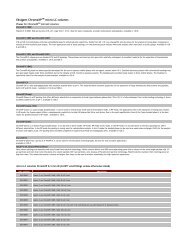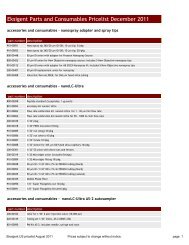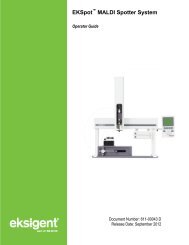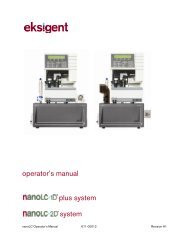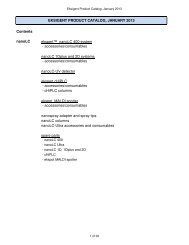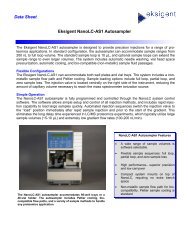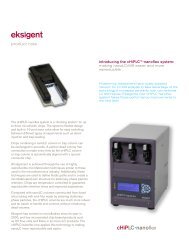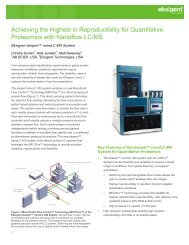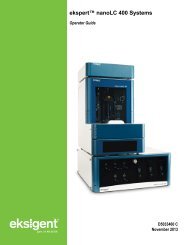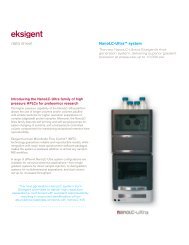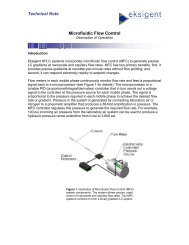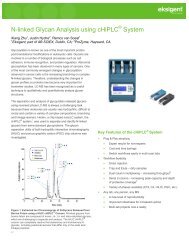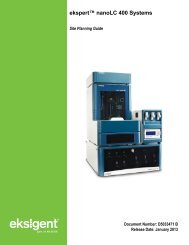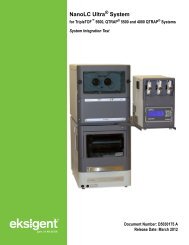AB SCIEX LC-MS/MS Analysis of Water using the Eksigent ekspert ...
AB SCIEX LC-MS/MS Analysis of Water using the Eksigent ekspert ...
AB SCIEX LC-MS/MS Analysis of Water using the Eksigent ekspert ...
- No tags were found...
Create successful ePaper yourself
Turn your PDF publications into a flip-book with our unique Google optimized e-Paper software.
ExperimentalLiquid Chromatography:All experimental data was acquired with <strong>the</strong> <strong>Eksigent</strong> <strong>ekspert</strong>micro<strong>LC</strong> 200 system equipped with a HTC-xt Dynamic Load andWash (DLW) autosampler. The <strong>ekspert</strong> micro<strong>LC</strong> 200 system’ssolvent delivery system is based on binary gradient pumps thatuse patented Micr<strong>of</strong>luidic Flow Control (MFC) pumptechnologyThe column used was an <strong>Eksigent</strong> ChromXP Halo Fused-Core2.7 µm, Phenyl Hexyl 0.5 x 150 mm. The column temperaturewas maintained at 30°C for all experiments. The mobile phaseswere ammonium formate in water and methanol. The flow ratewas set at 15 µL/min with a 4 µL injection volume.For <strong>the</strong> conventional HP<strong>LC</strong> experiments a Kinetex Fused-Corecolumn was used with a flow rate <strong>of</strong> 600 µL/min and a 4 µLinjection volume. The following gradient pr<strong>of</strong>ile was used for bothmicro flow and conventional flow (Table 1).Results and DiscussionThe aim <strong>of</strong> this work was to determine <strong>the</strong> quantitativeperformance <strong>using</strong> low volume injections with micro flow rates.To establish <strong>the</strong> performance a number <strong>of</strong> pesticides werespiked into water and serially diluted down to <strong>the</strong> limits <strong>of</strong>detection. The dilutions were analyzed at both flow rates;Figure 1 shows a comparison for Desphenyl-chloridazon at1ng/mL.Desphenyl-chloridazonMicro flow <strong>LC</strong>Desphenyl-chloridazonConventional flow <strong>LC</strong>Table 1. Analytical gradient pr<strong>of</strong>ile used at both flow ratesTime (min) A (%) B (%)Figure 1. Desphenyl-chloridazon analyzed <strong>using</strong> micro vs. conventionalflow <strong>LC</strong>-<strong>MS</strong>/<strong>MS</strong> (1 ng/mL)0.0 95 50.5 95 55.0 25 757.0 5 958.5 5 95At 1 ng/mL when comparing <strong>the</strong> peak areas at both flow rates<strong>the</strong> micro flow showed a 6.5 fold increase in peak area and a 10fold increase in signal to noise. The parent Chloridazon was alsoanalyzed and <strong>the</strong> comparison is shown in Figure 2.8.75 95 515.0 95 5Mass Spectrometry:The <strong>AB</strong> <strong>SCIEX</strong> QTRAP ® 4500 system was used for all dataacquisition. Analyses were performed <strong>using</strong> multiple reactionmonitoring (MRM) with simultaneous positive/negative switchingelectrospray ionization. The <strong>Eksigent</strong> hybrid 25 µm IDelectrospray electrode was used for all micro flow analyses. Thishybrid electrode is designed to minimize post column peakdispersion to maintain excellent peak shapes. 2 The sourcesettings were setup for micro flow rates with <strong>the</strong> curtain,nebulizer and heater gas set to 20 psi with a temperature <strong>of</strong>350°C. For <strong>the</strong> conventional flow rates <strong>the</strong> source conditionswere scaled to <strong>the</strong> appropriate values.ChloridazonMicro flow <strong>LC</strong>ChloridazonConventional flow <strong>LC</strong>Figure 2. Chloridazon analyzed <strong>using</strong> micro vs. conventional flow <strong>LC</strong>-<strong>MS</strong>/<strong>MS</strong> (1 ng/mL)p 2



